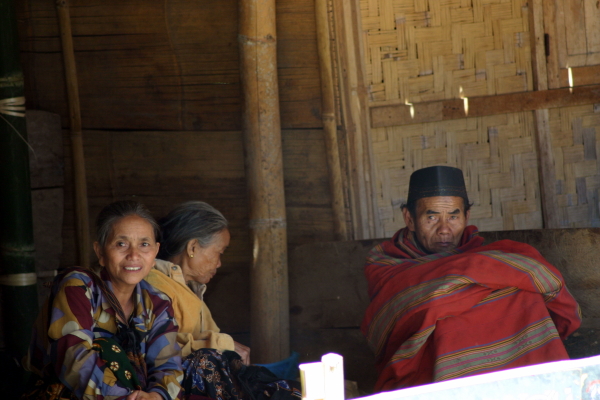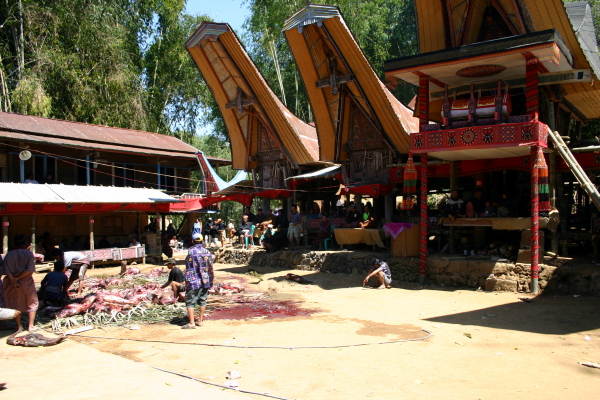Among the Torajan, no other celebration is as important as the one celebrating the passage from this world into the next one. Births and birthdays are practically non-events, and weddings pale in comparison. So elaborate and costly are the ceremonies that families must save up and plan for months if not years before the funeral can be held.
 This was my first view of the carnage of a Torajan funeral
This was my first view of the carnage of a Torajan funeral
When someone dies, their body is kept in the house with their family. In fact, the body is usually kept in the bedroom, with the family sleeping alongside the coffin. Once everything is ready, preparations are begun for the funeral party. Funerals are usually held during the dry season, from July to September. This is when the farming families will have the time as well as when the weather will be at its best.
 The village headman speaks at the funeral
The village headman speaks at the funeral
For the funeral, a set of temporary structures will be built in an open field near the family compound, or sometimes the structures are built between and around the permanent buildings to enclose a group of family houses. In either case, the temporary structures will form an enclosed courtyard. Most of the buildings will be nothing more than simple covered viewing platforms where guests can sit to observe the "festivities". The family of the deceased as well as close friends will essentially live on these platforms for the length of the funeral, which can last from three to seven days, depending on the importance of the dead person.
 Faces at a funeral
Faces at a funeral
The deceased, as honored guest, gets their own elaborate high platform from which to watch the show. The ceremony itself consists mostly of the sacrifice of pigs and buffaloes. Although ostensibly Christian, the Torajan still believe that the deceased needs the animals in the afterlife to carry them to heaven. The number of buffaloes slaughtered will also depend on the importance of the person who died. As many as 24 of the huge beasts may be killed for the most important people.
 The deceased (top right) gets pride of place at the funeral
The deceased (top right) gets pride of place at the funeral
The animals are butchered before the gathered crowd, and the meat may be given away or sometimes auctioned off, with the proceeds going to the church and to pay taxes. In order to curb excesses, the government put a tax on each buffalo slain. While the carving up proceeds, many ceremonies will have loudspeakers with a running commentary. At the funeral I attended, several people took turns speaking, including the village elder.
Although the funerals have become tourist attractions, they are not as yet put on for the benefit of tourists. In reality, there is no way to plan your trip to insure that one is going on while you're there. Most funerals are held July to September, but on my visit in early October 2006, there were apparently several going on or still to be held while I was there. I was a bit apprehensive about intruding on such an event, but I was not only welcomed, I was invited to join the head of the family on his platform for a cup of coffee.
Of course, once you have a funeral you have to bury the dearly departed, and Torajan graves are just as distinctive as their funerals.